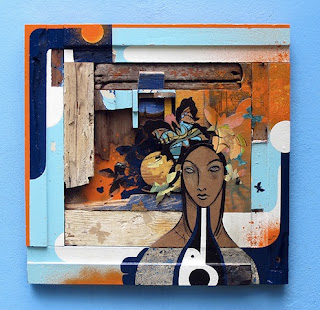 |
| This One Will Hold You In Her Arm, These in Their Mouths |
Taller Puertorriqueño
Dec. 10 to February 26, 2011
Multi media artists Chris Silva and Lauren Feece in their show “Rubber Swords, Lovers & Fighters,” at Taller Peurtorriqueño through their work channel the spirit of discovery, humor and collaboration. The young artists Christopher Tavares Siva, who is from Puerto Rico and his partner Lauren Elizabeth Feece, from the United States, have brought to the Lorenzo Homar Gallery installation, paintings, photographs and assemblages with drawings. The work in the gallery was all done in the last four years from their stay in Puerto Rico. The title of the show “Rubber Swords, Lovers & Fighters,” is both a nod to Mary Hirsch’s well known quote, “Humor is a rubber sword, it allows you to make a point without drawing blood,” and their collaboration and activism together.
The installation in the front of the gallery, “This One Will Hold You in Her Arm, These in Their Mouths,” is a combination of found wood discovered on the beach, painted in the bright colors of the Caribbean and cartoon drawings. It is a sprawling fort like work with drawn blue hands set apart at either end and somber faces staring back at you from walls. It’s parts seem not to be fastened together but set near each other to create a whole. Due to its flatness, and the somber simply drawn faces, it has a childlike quality that is both surprising and mysterious. It could be part of a theater set or a remnant to some youthful fantasy. Confronting it for the first time I can imagine allowing myself to be lost in its off-handed charm.
 |
| The Little Mermaid Realizes the Prince was a Douchebag |
In keeping to the tone of the show but in contrast in its scale is the assemblage “The Little Mermaid Realizes the Prince was a Douchebag.” It is a small work in the form of a flintlock pistol with a dour blue faced woman drawn on scraps of wood. The painted and worn scraps of wood form the body, a torn sign with the word “agua”(water) in blue block letters form the barrel, and a fin forms the handle with a nail sticking out where the hammer should be. The object is not large but hangs on the wall like an exclamation point signaling the punchline.
 |
| Sour Outlook Briefly Disarmed By Oh Holy Shit Life is Beautiful Moment |
To look at their work is to think of the time they are from. They are children of the age of Takashi Murakami. They are children of assemblages that mix history with artifacts, that cross cultures with abandon. Where high art meets Estsy. Where differences may be irrelevant, and function will always succumb to style. To reflect on their scale and use of medium is to explore a certain mindset. On the walls are individually painted skateboards. Next to them is an assemblage that seems almost to be a toy truck. Not far from it is a square work constructed of found wood and paper that would seem tame if not for its title, “Sour Outlook Briefly Disarmed By Oh Holy Shit Life Is Beautiful Moment." To take in the show as whole and accounting for their collaboration is to see the formation of a life style, a point of view, a melding that tries to be hopeful while being both playful and somber at the same time. The found materials in the installation are from the beaches of Peurto Rico, far from individually painted skateboards taken from an urban landscape. The cartoon imagery is from the rectangular TV screen that seemingly unites it all. The show starts from the installation and spreads itself out, and we are forced either to laugh or cry at its easygoing disjunction.
The Reception for show is Friday, December 10th, from 5 to 8PM










